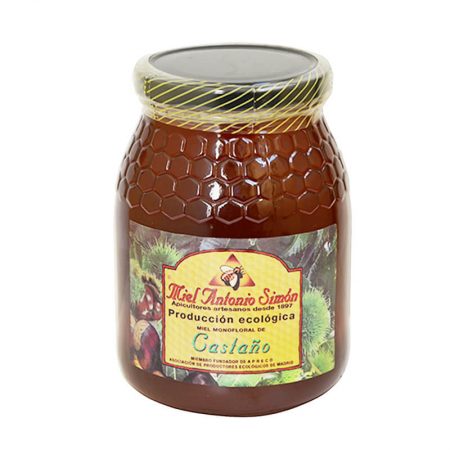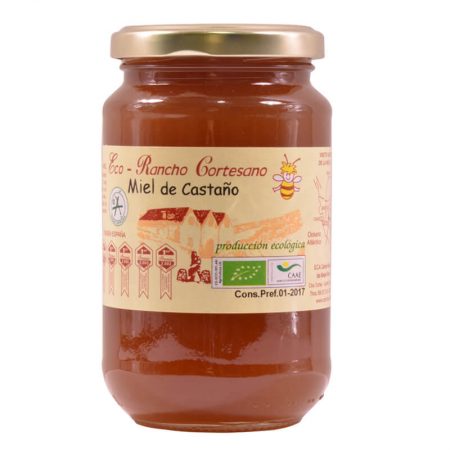Chestnut honey is a natural product made by honeybees from chestnut nectar and honeydew secretions. Although mainly from the nectar of chestnut flowers. One of the little-known honeys, but one that you’ll fall in love with once you try it!
The best selection of chestnut honey.
Index:
|
Summary: Chestnut honey is a dark honey with an intermediate aroma and a spectacular taste. Furthermore, this honey is very rich in minerals that provide great benefits for our health. Moreover, all our honeys come from Spanish beekeepers committed to quality and the environment care. It is also available in our shop in Las Rozas de Madrid.
Related articles: Raw unpasteurised honey
1. Our raw Chestnut Honey
Firstly, we show you the most important characteristics of honey of chestnut:
a) Colour
The honey of chestnut has an almost brown colour, with darker tones when it contains myelates or reddish tones when it contains heathers.
b) Aroma
A honey with a unique aroma. In summary, in tasting we can appreciate its strong aroma and smell of dry wood, somewhat less persistent and intense than that of eucalyptus honey. When tasting it, its sweet taste is appreciated, with salty notes. Furthermore, you can also find in it some bitter notes, if it had some heather or acid notes for carrying some brambles.
c) Crystallization
This honey has little tendency to crsitalization, except when it has some fabaceae. Consequently, fabaceae nectar accelerates its crystallization.
d) Chestnut tree
The chestnut tree is a large tree that can reach up to 25 metres in height. Furthermore, it is typical of the temperate zones of the northern hemisphere. Likewise, in Spain it is found mainly throughout the peninsula and the islands. Moreover, it grows preferably in shady and humid areas in the north and west of the Iberian Peninsula.
e) Flowering and harvesting
Chestnut honey is harvested in summer, and is homogeneous over time. However, it is negatively affected by high heat and is favoured by morning dew.
Video 1: Chestnut flowers
f) Pollen
Also, this honey has mostly Castanea sativa, but we can also find some heather, fabáceas and cistáceas. Although cistáceas tend to be less frequent.
g) Useful life
Furthermote, such honey may lose some property after two years.
h) Destination population
In addition, honey is great for everyone. However, do not feed raw honey to infants under 1 year of age without medical advise.
2. Benefits and properties
Chestnut honey is highly valued for its health benefits. Like all honey, has a high concentration of sugars. Furthermore, it also contains enzymes and components from chestnut that are very beneficial. For this reason, this honey has very positive effects, as we will document it below.
The effects that we are going to comment on come from researchers and from popular wisdom. Certainly, medicines are the only products that are patented and as such, they certify properties protected by the pharmaceutical industry.
Therefore, and indicating the references of research articles, we have found the following:
- According to an article published in 2017 by MG Miguel, MD Antunes and ML Faleiro, components of chestnut honey have a high bactericidal capacity. Therefore, these together with its composition low in water, make it very beneficial to act against infections such as colds and sore throats. It is also very suitable for wound healing.
- Also, this honey is rich in minerals, making it a very healthy food supplement.
Contraindications
Therefore, this is a summary of the different positive effects that we have found in scientific articles and books about the positive effects that this honey can have on our health.
Also, this honey has a low Glycemic Index, that it makes a honey suitable for diabetics
a) Contraindications
Chestnut honey has no contraindications, unless it is abused like any other product. Also, if you suffer from an allergy to chestnut pollen, as this honey contains considerable amounts of this pollen. You should also bear in mind that honey is a very calorific product, and consuming large quantities will make you gain weight.
3. Recommendations
We recommend this honey those who do not want a very sweet honey and a very powerful flavors.
Excellent on biscuits, toast, coffee and tea. Also, the great cooks usually use it to pair with Iberian meat, traditional stews and sweet and sour sauces.
4. Indications for Chestnut Honey
Raw chestnut honey takes several months to crystallise and is usually coarse-grained.
a) Honey from chestnut, heather and other sources
Chestnut honey, like all honeys, is not 100% chestnut honey. In the case of this honey, it is very common to find some heather.
5. Origin
The honey of Chestnut is obtained from several beekeepers in Spain, which are as follows:
Beekeeper |
Location |
Characterístics |
| Antonio Simón |
|
|
| Rancho Cortesano |
|
|
Table 1: Our beekeepers.
The multifloral honey from Zamora, although it is not mono-floral, will come from a considerable part of the Chestnut myelates. Also, there are other places in Spain that we will soon bring to our store.
Raw honey of chestnut from Galicia: Galicia would be where the largest amount of Chestnut honey is produced. However, it is also produced in other parts of Spain.
6. History
This tree was introduced by the Romans, and in many areas it became feral. This tree comes from Asia Minor. It was first brought to Greece and later to Italy, France and Spain.
On the other hand, Discorides also deals with the chestnut tree in chapter 122 of book I. The name chestnut comes from the Greek “kastanaikon karyon” which derives from Kastana, a city in Pontus where the tree was first cultivated in ancient times.
a) Curiosities
In the south of Spain, in the mountains of San Pedro de Alcántara, we have a famous chestnut tree called “castaño santo”, which is the grandfather of this forest. The locals also say that this chestnut tree is between 800 and 1000 years old. What is clear is that its trunk measures 14 metres in diameter.
7. FAQ
In addition, these are frequently asked questions:
-
Is this honey very strong?
For a dark honey, it does not have such a strong flavour as heather and forest honey. Subsequently, it has an intermediate taste.
-
Is chestnut honey similar to heather honey?
Chestnut honey has a milder taste than heather honey. However, chestnut honey has very often some heather honey in it.
Source:
Heart Foundation https://fundaciondelcorazon.com/





